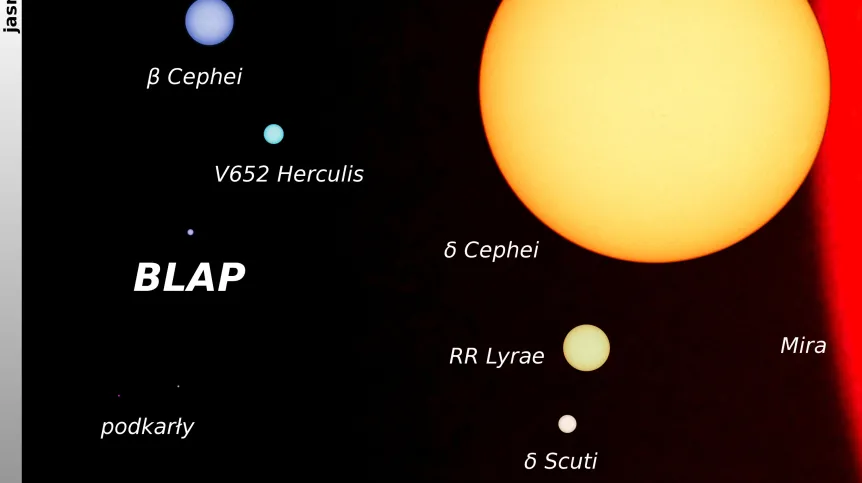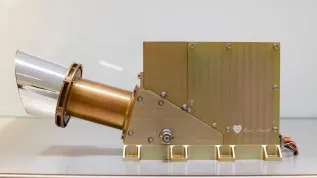
A new class of pulsating stars (BLAP) has been discovered by a team of astronomers from the University of Warsaw. Every half an hour, these stars change their radius by a dozen or so percent, they expand and then shrink again.
Chile, Atacama Desert, Andean Ridge, Las Campanas Observatory where the Warsaw Southern Observatory is located, 2300 m above sea level, 4 AM. Dr. Paweł Pietrukowicz from the Astronomical Observatory of the University of Warsaw is halfway through his shift at the telescope, but has found time to talk to PAP about his team\'s discovery described in the prestigious journal Nature Astronomy (http://nature.com/articles/doi:10.1038). / s41550-017-0166).
Polish researchers have observed blue pulsating stars, which change their radius by about a dozen percent every 20-40 minutes - so they expand and shrink with quite a high frequency. They have been called BLAP (Blue Large-Amplitude Pulsators).
"We specialize in continuous monitoring of the stars in our galaxy - every night we observe about one billion stars. Among them, we spot the objects that change in time. And in this variability we find fascinating information" - he explained.
And so astronomers track changes in the brightness of objects in the sky, observe the explosions of new stars and supernovae, dancing binary stars, and look for new planets in distant systems. Among the objects in the sky that change their brightness are also pulsating stars - including Cepheids and Mira stars.
Previously astronomers observed stars that change their brightness significantly - with great amplitude - but slowly, with periods of hours, days or even years. "And we found a completely new class of stars - pulsating stars that change brightness with high amplitude in a very short time. No one before us has tracked such objects" - he said.
"Such brightness changes are huge if we imagine that these objects are only slightly smaller than our sun" - the astronomer explained. In order to discover the reasons for this variability, astronomers performed a series of additional observations using the world\'s largest telescopes. They showed that the newly discovered objects have temperatures of as much as 30,000 Kelvin (so they are much hotter than the Sun - 5800 Kelvin), and the cause of variability are pulsations. On this basis a star model was developed. It turns out that it is similar to giant star models - 96 percent mass is concentrated in a core of just 20 percent of the radius of the whole star. The rest is a lightly expanded shell that pulsates in rapid rhythm - hence the large amplitude of changes in brightness.
Researchers have been able to identify 14 such new stars. All are located in our galaxy.
It is still unknown how these objects formed. "The most likely scenario is that the objects we investigated were formed by the merging of two stars. But this puzzle is still waiting for a solution" - smiled Dr. Pietrukowicz.
The scientist talked about the work of an astronomer. "People think that we stand next to a telescope and put an eye to it. But astronomical plates were introduced into astronomy already about 150 years ago. And three decades ago they were replaced by CCD cameras" - he said. And added: "Our telescope is connected to a camera that on a single clear night captures images of the sky that take a total of up to 100 GB of memory". Dr Pietrukowicz explained that huge hard drives are needed to archive such amounts of data, and supercomputers to analyse this information on an ongoing basis. "Astronomer\'s work is basically working on a computer" - he said.
Either way, every night one of the astronomers from the team is on duty at the observatory in the Chilean wilderness. Astronomers have to monitor the operation of the telescope, track the weather and select the clear sky areas, at which the telescope is pointed.
"This night is unfortunately cloudy, but that sometimes happens this winter" - said Pietrukowicz. He noted, however, that Las Campanas is one of the best locations on Earth to observe the sky. Over the course of the year, there are on average 300 nights clear enough to study the stars.
The research was part of the project The Optical Gravitational Lensing Experiment (OGLE), headed by Prof. Andrzej Udalski from the Astronomical Observatory of the University of Warsaw. Over the 25 years of the project, OGLE\'s astronomers discovered and classified around a million periodic stars, nearly half of which are pulsating stars. This is the largest collection in the history of world astronomy.
PAP - Science and Scholarship in Poland, Ludwika Tomala
lt/ ekr/ kap/
tr. RL













